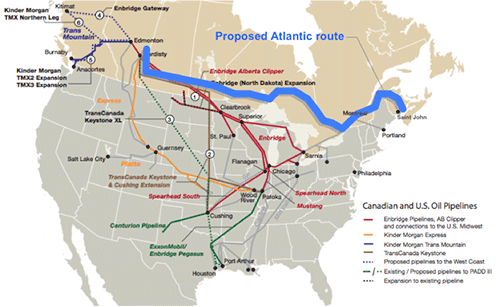Blog
The ever-expanding oil sands delivery network
Increasingly, global oil demand pushes us to harder-to-get-at, more remote, and dirtier oil sources. Maybe you’ve heard about the resource in Canada that is sometimes referred to as “oil sands.” Currently it delivers about 2 million barrels per day to help fuel the world’s energy demand. This resource is immense. The oil giant BP estimates that this resource is good for about 170 billion barrels of proved reserves. Considering all the permits and plans of the oil and gas industry, the world might draw up to 6 or even 9 million barrels per day from this resource eventually, depending on oil demand and many other factors (e.g., how easily energy companies can get this oil to the global market). If all of this resource went to the U.S., it would fuel roughly half of U.S. petroleum demand. But of course the target for this fungible and tradable fuel is to get it to the world market, where it could amount to roughly 10% of global oil demand.
Unfortunately this oil sands resource has higher carbon emissions than conventional oils. My colleague Chris Malins points out one place (i.e., at the refinery) that these unconventional fuels contribute more carbon to the atmosphere. Of course there are many other sources (see here, here, here, here, here, here) that point to oil sands’ higher carbon emissions. And all this will play into the White House’s and State Department’s determination about whether to approve the Keystone XL pipeline to help bring this fuel to the world via the Gulf of Mexico.
The latest in this long story about how industry might bring this rather dirty oil to market is a proposal to bring about 1.1 million barrels per day across nearly the entire continent of North America, or about 2700 miles, to Saint John, New Brunswick. Adding this to the existing oil sands flow, this would bring us to about 3.1 million barrels of oil sands-based fuels globally – a third of the way to oil sands proponents’ hoped-for target of 9 million barrels per day. Below is a map of the route, along with other proposed and known routes. Also there are many new “smaller” rail-based routes that are opening up. For example, the San Francisco Bay Area is apparently a new destination for Canada’s heavy unconventional oils. There is much contention over how, and how much, of Alberta’s oil sands is making it to and through the US market. Per Reuters and our NRDC colleagues’ discussion, most of the fuel is staying mostly in the Midwest US. At least for now. And recently there was a new terminal that would increase the rail output from Alberta by another 140,000 barrels per day). As is clear, the oil industry is seeking, and finding, many ways to bring this fuel to the market.
Of course, the energy sector will relentlessly seek to bring energy supply to the energy demand in the most profitable way that it can. Shifting the fuel supply to less carbonaceous sources is critical (and may also be possible with regulation). So, too, is shifting to shifting to more efficient vehicles, more efficient ships, and more efficient trucks. We may well need “all of the above” to help stem the tide.

